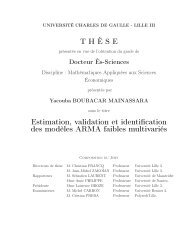Generalizing the Bardos-LeRoux-Nédélec boundary condition for ...
Generalizing the Bardos-LeRoux-Nédélec boundary condition for ...
Generalizing the Bardos-LeRoux-Nédélec boundary condition for ...
Create successful ePaper yourself
Turn your PDF publications into a flip-book with our unique Google optimized e-Paper software.
The problem BLN <strong>condition</strong> & Alternatives Effective BC graph Definition Uniqueness Definition Bis Existence & Convergence of Approximations<br />
...Uniqueness, comparison, L 1 contraction.<br />
For <strong>the</strong> proof, by <strong>the</strong> Kruzhkov’s doubling of variables argument<br />
applied “inside Ω” one deduces <strong>the</strong> “local Kato inequality”<br />
<br />
(u−û) + <br />
(t)ξ ≤ (u0−û0) + t<br />
ξ(0, ·) + q + (u, û) · ∇ξ<br />
Ω<br />
Ω<br />
0<br />
Ω<br />
<strong>for</strong> all ξ ∈ D([0, t] × Ω).<br />
Take <strong>for</strong> ξ ∈ D(R × RN ) truncation-near-<strong>the</strong>-<strong>boundary</strong> functions ξh.<br />
We “pay” <strong>for</strong> this truncation with a new term which is “dissipative”.<br />
Indeed,<br />
t<br />
(∗)<br />
as h ↓ 0,<br />
0<br />
q<br />
Ω<br />
+ t<br />
(u, û) · ∇ξh −→ −<br />
0<br />
γwq<br />
∂Ω<br />
+ t<br />
(u, û)<br />
= − q + (γu, γû) ≤ ??? 0,<br />
0<br />
∂Ω
















